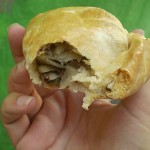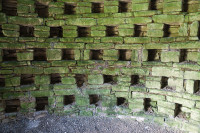
No, no, no—not those. I know what you’re thinking.
I’m talking about one of the food staples of the iron ore workers in the Upper Peninsula of Michigan—the pasty. Think in terms of a giant Italian Stromboli. A flaky crust (usually a pie crust) enveloping meat, diced potatoes, carrots, onions, or anything Mom or Dad could think of. It was (and is) a hearty baked meal—one to satisfy the hunger of very hard working people.
Do you know why the edges of the pasty are so thick? It’s because the iron ore workers didn’t wash their hands and so they picked up the pasty by the outer crust and then discarded the crust after eating the main section of the pasty.
Pasties were eaten in the Middle Ages as part of the supper. Instead of beef or pork, the meat would usually be roast boar, pigeon, or wild game that was hunted. The pasty originated in England, and in particular, Cornwall where miners ate them for lunch. By the mid-1800s, the pasty had been introduced to the diet of the Upper Peninsula miners.
Today, we raise turkeys, pigs, cattle, and other animals for our consumption. During the Middle Ages, other animals were considered a delicacy. Besides the boar, deer, and other hunted animals, the nobility would gather up, fatten up, and glutton up on the following:
- Dormice—these little critters were the edible version of what we think of today. They were kept in pens while being fed walnuts and chestnuts to fatten them. To eat a dormice was a delicacy reserved for special holidays.
- Pigeons—the birds were kept in their own special houses called dovecotes. These freestanding structures would have little “condos” in the interior where the pigeons could live. By royal decree, only the nobility were allowed to have dovecotes (when you visit the French châteaux, always look for the free standing dovecotes). When it came time for supper, the chef would go out to the dovecote and pluck a couple of unlucky birds.
Inside a Dovecote

The Dovecote next to Penmon Priory on Anglesey. An impressive early 17th century dovecote.
- Cockentryce—this must have been the forerunner to John Madden’s “turducken.” It was a half pig sewn to half of a castrated and fattened chicken.
- Beaver’s tails—believe it or not, this was substituted for fish during fasting days (i.e., no meat allowed). Supposedly, a beaver’s tail tastes like fish. I’ll let you be the judge of that one. On a final note, I can’t leave out a much sought after (and expensive) delicacy:
- Ambergris—this was produced in the digestive system of a gray whale. It would be vomited out by the whale, washed up on the beach, and then consumed with items like eggs, pies, or cakes. King Charles II of England was a big fan of this scarce delicacy.
Do you think that five hundred years from now, robots and computers will be talking about what we eat today?
Best Pasty in America
All due respect to the pasties my wife and Dad make, the best pasty I’ve ever had is at Suzy’s Pasties located at 1020 US 2 W in Saint Ignace, Michigan.
After you get off the Mackinac Bridge going west on Highway 2, her restaurant will be on the right (a mile or two). The crust is the best I’ve ever had. If it’s not open when you get there, I have a feeling it doesn’t really matter. You can stop along the interstate just about anywhere as long as the restaurant specializes in pasties.
Want to make a pasty? Check this out. Remember, the secret to a great pasty is the crust. Perhaps you might want to try diced cockentryce in your next pasty and then slather it up with Ambergris? Actually, Ambergris is illegal today.
We Need Your Help
Please tell your friends about our blog site and encourage them to visit and perhaps subscribe to it. Sandy and I are trying to increase our audience and we need your help through your friends, followers, and social media contacts.
Thank You
Sandy and I appreciate you visiting with us. We have some exciting things on the horizon and we’ll keep you updated through each blog post.
What’s New With Sandy and Stew?
The final edited manuscripts (two volumes) for the walking tour of medieval Paris have been submitted to our book designer. It was a lot of fun picking out the illustrations, pictures, and images for the books. I’m looking forward to seeing the first draft of the book. It shouldn’t be too long before we go to print.
We have a lot of stories and we’re looking forward to sharing these with you. Please continue to visit our blog site and perhaps you’d like to subscribe so that you don’t miss out on our blog posts, past and current.
Please note that we do not and will not take compensation from individuals or companies mentioned or promoted in the blogs.
Are you following us on Facebook and Twitter?
Share This:

Copyright © 2015 Stew Ross


Nice article! I enjoyed the tidbit about the crust size :). Are you from Michigan then? Ohio native here.